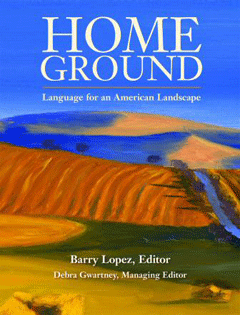The Language of Landscape
Air Date: Week of June 13, 2008

Living on Earth its series "Home Ground: Language for an American Landscape," based on the book of the same title edited by Barry Lopez and Debra Gwartney. In this installment, Oregon writer John Daniel muses on the word "blaze.”
Transcript
GELLERMAN: Well, Bandelier National Monument gets its name from Adolph Bandelier, a Swiss archeologist who studied ancient Pueblo Indian sites. The language that we use to describe our landscape often has origins and meanings that are lost to us now. The book “Home Ground: Language for an American Landscape” reminds us of where the terms that define our environment come from. The book was compiled by Barry Lopez and Debra Gwartney and from time to time we’ve been featuring some of those terms on Living on Earth.
Today - writer John Daniel and his description of the term “blaze”.
DANIEL: Blaze. Blaze, meaning a white patch on a horse’s forehead, was applied by English colonists to the marking of a forest route by periodically axing off a piece of tree bark to expose a portion of lighter-colored wood.

GELLERMAN: John Daniel is a writer whose Home Ground is the foothills west of Eugene Oregon. His description of ‘blaze’ came from “Home Ground: Language for an American Landscape” compiled by Barry Lopez and Debra Gwartney.
[MUSIC: Joni Mitchell: “Refuge From The Road” from Hejira (Asylum Records 1975)]
GELLERMAN: For 35 years the Telluride Bluegrass Festival has been going strong.
Living on Earth wants to hear from you!
Living on Earth
62 Calef Highway, Suite 212
Lee, NH 03861
Telephone: 617-287-4121
E-mail: comments@loe.org
Newsletter [Click here]
Donate to Living on Earth!
Living on Earth is an independent media program and relies entirely on contributions from listeners and institutions supporting public service. Please donate now to preserve an independent environmental voice.
NewsletterLiving on Earth offers a weekly delivery of the show's rundown to your mailbox. Sign up for our newsletter today!
 Sailors For The Sea: Be the change you want to sea.
Sailors For The Sea: Be the change you want to sea.
 The Grantham Foundation for the Protection of the Environment: Committed to protecting and improving the health of the global environment.
The Grantham Foundation for the Protection of the Environment: Committed to protecting and improving the health of the global environment.
 Contribute to Living on Earth and receive, as our gift to you, an archival print of one of Mark Seth Lender's extraordinary wildlife photographs. Follow the link to see Mark's current collection of photographs.
Contribute to Living on Earth and receive, as our gift to you, an archival print of one of Mark Seth Lender's extraordinary wildlife photographs. Follow the link to see Mark's current collection of photographs.
 Buy a signed copy of Mark Seth Lender's book Smeagull the Seagull & support Living on Earth
Buy a signed copy of Mark Seth Lender's book Smeagull the Seagull & support Living on Earth

